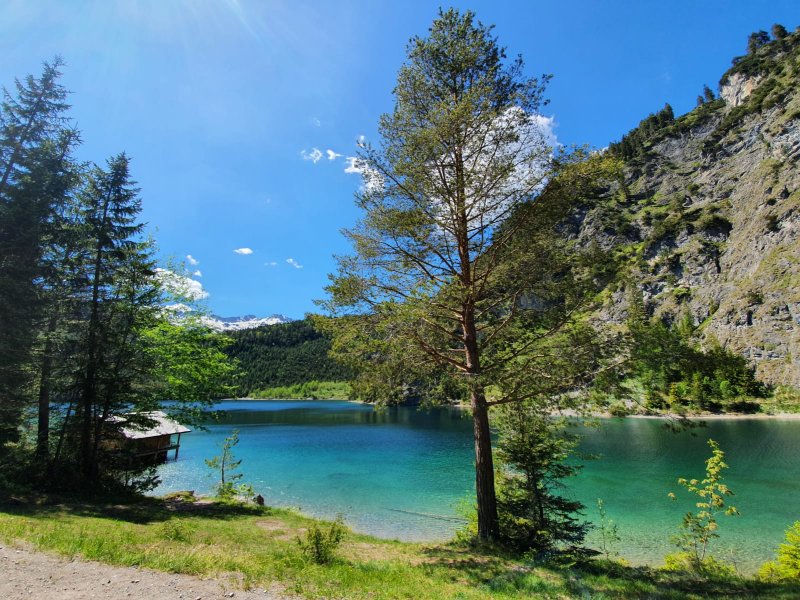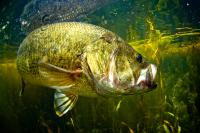
Blindsee
- 3014
North of the Fernpass, at almost 1100 m, lies the 25 m deep Blindsee Lake. High fish abundance, sunken landscapes of roots and trees in combination with unbelievable visibility allow for fantastic dives. Tthere is also a lot to discover for the macro-lovers.
Large shoals of minnows and fish stocking of various trout, whitefish, pike and zander. But also snails, freshwater sponges, yellow fungus beetles, and more.
10
Wildlife Species
11
SSI Training Centers
13m / 43ft
Max. Depth
beginner
Level
Top Wildlife Sightings

Bass
The bass is a perch-like fish encompassing many different species, both marine and freshwater. He can be found in lakes, streams and rivers all around the world, are one of the most popular game fish, and a favorite catch for fishermen. The largemouth bass is probably the most well-known and includes big mouth, black, largies, bucketmouth, wide mouth, and green bass, just to name a few.
Show More
Pike
Hechte sind Süßwasser Raubfische, die mit ihrem länglichen Körper, der spitzen Schnauze und den großen, scharfen Zähnen leicht zu identifizieren sind. Sowohl ihre Rücken- als auch ihre Afterflossen sind weit hinten am Schwanz angesetzt, wodurch sie noch länger erscheinen, als sie ohnehin schon sind. Diese gefräßigen Jäger sind sowohl in Nordamerika, Europa als auch in Nordasien beliebte Wildfische. Das Tauchen mit Hechten ist ein unvergessliches Erlebnis, da sie recht groß werden können und mit ihren blass- bis leuchtend gelben, bohnenförmigen Flecken am ganzen Körper, und ihren leuchtend orange bis rot gefärbten Flossen unter Wasser sehr hübsch sind.
Show More
Carp
The carp originated as an ornamental and aquaculture fish in China but has spread as an invasive species worldwide. In fact, the common species has now spread to inhabit all continents in the world except Antarctica. Ironically enough, native wild populations in Asia are actually considered vulnerable to extinction yet are highly destructive and abundant in waters in other parts of the world where it’s not supposed to be found.
Show More
Trout
One of the more beautiful types of freshwater fish, trout is the common name for a large number of different freshwater species closely related to salmon. They live exclusively in freshwater lakes and rivers and come in a wide variety of colors that change based on their environment, making them masters at camouflage. Preferring cool, clear streams and lakes, they can be found in waters averaging 10-16 degrees C (50-60 degrees F) so if you want to go diving with trout you better bring a thick wetsuit.
Show More
Walleye
Sometimes called the yellow pike, walleye is a common freshwater species native to North American lakes and rivers. They are most commonly found in large lakes throughout the northern United States and all throughout Canada, making them a popular game fish for anglers. In fact, it was such a desired game fish that, over the last century, they have been introduced into lakes where they were not naturally found; therefore, increasing their distribution even more.
Show More
Perch
Perch are a famous freshwater game fish, with many species resembling it; however, there are only three actual species which occur in different geographical areas around the world: Europe, Asia, and North America. They are abundantly distributed in freshwater lakes throughout these regions and are popular for both sport fishing and for food. They are easily identifiable by their somewhat long, rounded bodies, two dorsal fins of which the first is spiny and the second soft, and black vertical stripes.
Show More
Common Rudd
Originating from the carp family, Cyprinidae, the common rudd is indigenous to the freshwater lakes and rivers of Europe and Asia. Unfortunately, it is also widely spread throughout North America, where it is an invasive species called American, or pearl, roach. Within its natural distribution, the common rudd is usually found around the freshwater basins of the North, Baltic, Black, Caspian, and Aral seas.
Show More
Char
The char fish, also known as Arctic char, is a close relative to the trout and salmon of North America. Arctic char are commonly found in the cold, deep lakes and rivers of the New England area of North America. It is also widely distributed throughout the North Atlantic to Europe and the icy Pacific waters near Alaska. The char fish is an excellent source of food and popular sport fish, gaining in popularity as a flavorful fish like salmon.
Show More
Tench
The tench is a common European freshwater fish that has been introduced to much of the world. Although it is native to the lakes and lowland rivers of Europe and parts of Asia, the tench has become an invasive species throughout North America. The tench was introduced by humans to every continent on earth besides Antarctica as a sport and food fish. They are most often found in still waters with clay or muddy bottoms and abundant vegetation and can tolerate waterways with significantly low oxygen levels.
Show MoreRated Dives
Temperature & Visibility
This data is provided from the logbook information in the MySSI app
Affiliated Training Center
Dive sites nearby

Samarangersee

Fernsteinsee

Planseecamp

Urisee

Walchensee, Einsiedlbucht

Walchensee, Walchenseebucht / Radlbucht

Walchensee, Am Hackl (VW Käfer)

Walchensee, Steinbruch

Walchensee, Galerie

Walchensee
The dive spots and related content on MyDiveGuide are provided for informational and promotional purposes only. This information, including user-generated content, is not definitive advice or recommendations. Divers are fully responsible for planning their dives, ensuring adequate safety equipment, verifying diving permissions, and complying with local laws and regulations. SSI, MyDiveGuide, and affiliates assume no responsibility or liability for divers' actions, choices, or any incidents. Always dive within your training limits, prioritize safety, and confirm that diving is permitted at your chosen location.